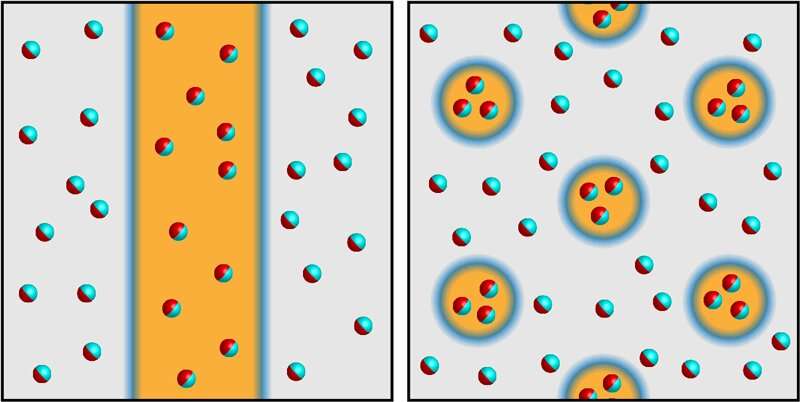(Left) A sketch of the one-dimensional order-parameter modulation in the FFLO state of organic superconductors, where the stripes correspond to different superconducting phases separated by magnetically ordered regions (blue). (Right) The two-dimensional polka-dot pattern proposed by Saunders, Parpia, and colleagues to explain nuclear magnetic resonance observations of superfluid helium-3. The domains here correspond to different superfluid phases (B+ and B−), which are separated by nonsuperfluid domain walls (blue). Credit: APS/Alan Stonebraker
A team of researchers from Royal Holloway University of London and Cornell University has found that a polka-dot pattern emerges in superfluid helium-3 when it is placed in a thin cavity and subjected to a magnetic field. They have published their findings in the journal Physical Review Letters.
A lot of work over the past several years has shown that superconductivity is quite common in metals subjected to very cold temperatures. Scientists have found that the zero-resistance state arises due to electrons forming a condensate of Cooper pairs that carry electrical current without losing any of it. Less well known is that similar pairings happen in neutron stars, quark matter, some gases at very low temperatures and neutral helium-3 atoms. In this new effort, the researchers were studying the behavior of such atoms under varying conditions, and in so doing, discovered that a 2-D pattern appeared in superfluid helium-3 when it was confined using a magnetic field.
In their work, the researchers pumped helium-3 into a silicon-glass cell with an inner cavity that had a height of just 1.1um—they increased the pressure inside to 30 mbar. Next, they took pulsed nuclear magnetic resonance measurements in an applied magnetic field of 31 mT. They report that doing so allowed them to identify two B phases in the cavity. They note that they were expecting to see single-dimensional modulation in both B+ and B- phases, and stripes would form with walls between them made of non-superfluid material. Instead, they found that the area of the B+ domain was four times bigger than the B- domain. They noted that this meant that their stripe assumptions were incorrect. To explain the difference, they suggest a 2-D modulation in superfluid order in which the B-domains are patterned like polka-dots within a B+ domain.
The researchers note that their findings open the door to more questions, such as the size of the polka-dots and the distance between them. Additionally, the nature of the boundaries is unknown as yet. Because the pattern was unexpected, new theories are required to explain it.
More information: Lev V. Levitin et al. Evidence for a Spatially Modulated Superfluid Phase of He3 under Confinement, Physical Review Letters (2019). DOI: 10.1103/PhysRevLett.122.085301 , arxiv.org/abs/1805.02053
Journal information: Physical Review Letters
© 2019 Science X Network























